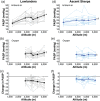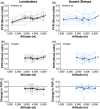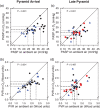Pulmonary vascular reactivity to supplemental oxygen in Sherpa and lowlanders during gradual ascent to high altitude
- PMID: 36404588
- PMCID: PMC10103769
- DOI: 10.1113/EP090458
Pulmonary vascular reactivity to supplemental oxygen in Sherpa and lowlanders during gradual ascent to high altitude
Abstract
New findings: What is the central question of this study? How does hypoxic pulmonary vasoconstriction and the response to supplemental oxygen change over time at high altitude? What is the main finding and its importance? Lowlanders and partially de-acclimatized Sherpa both demonstrated pulmonary vascular responsiveness to supplemental oxygen that was maintained for 12 days' exposure to progressively increasing altitude. An additional 2 weeks' acclimatization at 5050 m altitude rendered the pulmonary vasculature minimally responsive to oxygen similar to the fully acclimatized non-ascent Sherpa. Additional hypoxic exposure at that time point did not augment hypoxic pulmonary vasoconstriction.
Abstract: Prolonged alveolar hypoxia leads to pulmonary vascular remodelling. We examined the time course at altitude, over which hypoxic pulmonary vasoconstriction goes from being acutely reversible to potentially irreversible. Study subjects were lowlanders (n = 20) and two Sherpa groups. All Sherpa were born and raised at altitude. One group (ascent Sherpa, n = 11) left altitude and after de-acclimatization in Kathmandu for ∼7 days re-ascended with the lowlanders over 8-10 days to 5050 m. The second Sherpa group (non-ascent Sherpa, n = 12) remained continuously at altitude. Pulmonary artery systolic pressure (PASP) and pulmonary vascular resistance (PVR) were measured while breathing ambient air and following supplemental oxygen. During ascent PASP and PVR increased in lowlanders and ascent Sherpa; however, with supplemental oxygen, lowlanders had significantly greater decrease in PASP (P = 0.02) and PVR (P = 0.02). After ∼14 days at 5050 m, PASP decreased with supplemental oxygen (mean decrease: 3.9 mmHg, 95% CI 2.1-5.7 mmHg, P < 0.001); however, PVR was unchanged (P = 0.49). In conclusion, PASP and PVR increased with gradual ascent to altitude and decreased via oxygen supplementation in both lowlanders and ascent Sherpa. Following ∼14 days at 5050 m altitude, there was no change in PVR to hypoxia or O2 supplementation in lowlanders or either Sherpa group. These data show that both duration of exposure and residential altitude influence the pulmonary vascular responses to hypoxia.
Keywords: Sherpa; high altitude; hypoxia; hypoxic pulmonary vascular remodelling; hypoxic pulmonary vasoconstriction.
© 2022 The Authors. Experimental Physiology published by John Wiley & Sons Ltd on behalf of The Physiological Society.
Conflict of interest statement
All authors declare that they have no competing interests or conflicts of interest to disclose.
Figures






Similar articles
-
Influence of iron manipulation on hypoxic pulmonary vasoconstriction and pulmonary reactivity during ascent and acclimatization to 5050 m.J Physiol. 2021 Mar;599(5):1685-1708. doi: 10.1113/JP281114. Epub 2021 Feb 3. J Physiol. 2021. PMID: 33442904
-
Baroreflex control of sympathetic vasomotor activity and resting arterial pressure at high altitude: insight from Lowlanders and Sherpa.J Physiol. 2019 May;597(9):2379-2390. doi: 10.1113/JP277663. Epub 2019 Apr 7. J Physiol. 2019. PMID: 30893472 Free PMC article.
-
UBC-Nepal expedition: phenotypical evidence for evolutionary adaptation in the control of cerebral blood flow and oxygen delivery at high altitude.J Physiol. 2019 Jun;597(12):2993-3008. doi: 10.1113/JP277596. Epub 2019 May 13. J Physiol. 2019. PMID: 31026348
-
Short-term adaptation and chronic cardiac remodelling to high altitude in lowlander natives and Himalayan Sherpa.Exp Physiol. 2015 Nov;100(11):1242-6. doi: 10.1113/expphysiol.2014.082503. Epub 2014 Nov 20. Exp Physiol. 2015. PMID: 26575341 Review.
-
Neuromuscular fatigability at high altitude: Lowlanders with acute and chronic exposure, and native highlanders.Acta Physiol (Oxf). 2022 Apr;234(4):e13788. doi: 10.1111/apha.13788. Epub 2022 Jan 25. Acta Physiol (Oxf). 2022. PMID: 35007386 Free PMC article. Review.
Cited by
-
On the mechanisms underlying activation and reversal of high altitude-induced pulmonary hypertension in humans - Another piece in the pulmonary puzzle.Exp Physiol. 2023 Jan;108(1):1-4. doi: 10.1113/EP090967. Epub 2022 Nov 21. Exp Physiol. 2023. PMID: 36409273 Free PMC article. No abstract available.
-
A song of iron and oxygen: Hypoxic pulmonary vasoconstriction and gas exchange in chronic obstructive pulmonary disease.Exp Physiol. 2023 Apr;108(4):535-538. doi: 10.1113/EP091078. Epub 2023 Feb 6. Exp Physiol. 2023. PMID: 36744659 Free PMC article. No abstract available.
References
-
- Aessopos, A. , Farmakis, D. , Taktikou, H. , & Loukopoulos, D. (2000). Doppler‐determined peak systolic tricuspid pressure gradient in persons with normal pulmonary function and tricuspid regurgitation. Journal of the American Society of Echocardiography, 13(7), 645–649. - PubMed
-
- Balanos, G. M. , Talbot, N. P. , Dorrington, K. L. , & Robbins, P. A. (2003). Human pulmonary vascular response to 4 h of hypercapnia and hypocapnia measured using doppler echocardiography. Journal of Applied Physiology, 94(4), 1543–1551. - PubMed
-
- Banchero, N. , & Cruz, J. C. (1970). Hemodynamic changes in the Andean native after two years at sea level. Aerospace Medicine, 41, 849–853. - PubMed
-
- Bertini, M. , Sengupta, P. P. , Nucifora, G. , Delgado, V. , Ng, A. C. , Marsan, N. A. , Shanks, M. , van Bommel, R. J. , Schalij, M. J. , Narula, J. , & Bax, J. J. (2009). Role of left ventricular twist mechanics in the assessment of cardiac dyssynchrony in heart failure. JACC Cardiovasc Imaging, 2(12), 1425–1435. - PubMed
-
- Bhandari, S. , Zhang, X. , Cui, C. , Bianba, Liao, S. , Peng, Y. , Zhang, H. , Xiang, K. , Shi, H. , Ouzhuluobu, Baimakongzhuo, Gonggalanzi, Liu, S. , Gengdeng, Wu, T. , Qi, X. , & Su, B. (2015). Genetic evidence of a recent Tibetan ancestry to Sherpas in the Himalayan region. Scientific Reports, 5(1), 16249. - PMC - PubMed
MeSH terms
Substances
LinkOut - more resources
Full Text Sources
Research Materials

